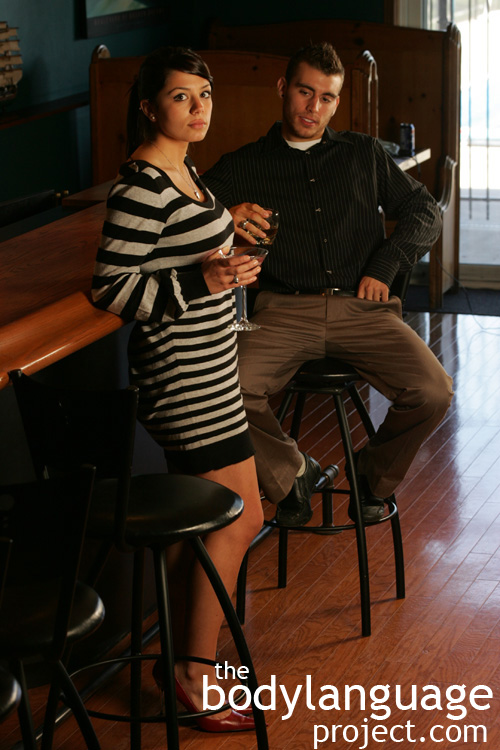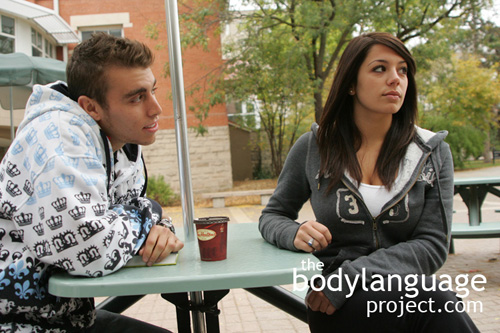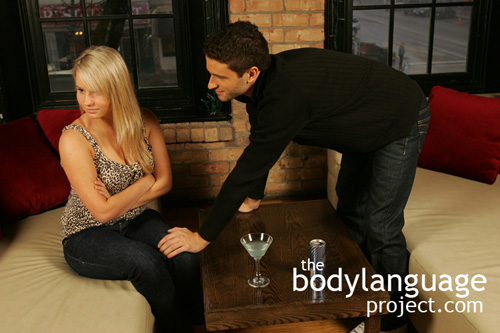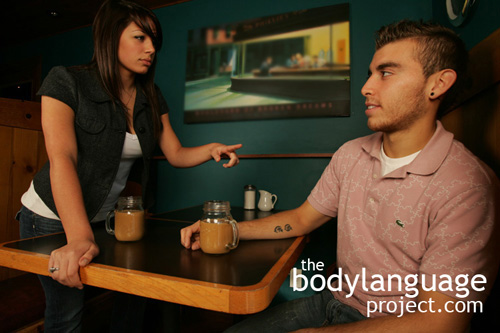Body Language of Leg Crossing and Leg Crossing Direction

 Cue: Leg Crossing and Leg Crossing Direction.
Cue: Leg Crossing and Leg Crossing Direction.
Synonym(s): Crossing The Legs, Thigh-Thigh Cross.
Description: A proper sitting posture where one leg crosses over the knee of the other leg.
In One Sentence: Leg crossing is a closed body posture demonstrating the desire to protect privacy.
How To Use it: Women should make it a habit to cross the legs regardless of the type of attire they wear, but especially so if they are wearing short skirts or dresses or are trying to appear feminine. Our current culture affords women the liberty to comport themselves however they see fit, however, this does speak directly toward our values. In other words, if women wish to be perceived as “lady-like” and feminine, rather than masculine (the current default), crossing the legs is an apt nonverbal display.
Men also benefit from crossing the legs, much like women. When men cross their legs rather than splay them open, they appear more proper and sophisticated, not to mention respectful.
As always, one must use body language to create the results that are most desired.
Context: a) General, b) Dating.
Verbal Translation: “I’m somewhat reserved so I’m closing off my body and aiming my legs toward someone I like or away from someone I dislike.”
Variant: Sometimes people are not physically able or comfortable crossing their legs in more than one direction or crossing them at all. If a person habitually crosses their legs in one direction, their tendons and muscles will stretch and conform to suite that direction best. This then inhibits them from crossing in another direction because they feel less comfortable doing so. Therefore, we should be careful to watch for adjoining cues, the context, and a person’s baseline before drawing definitive causal conclusions with respect to leg cross direction.
See European Leg Cross and Figure Four Seating Position (The) or The Ankle-Knee Cross and Leg Twine.
Cue In Action: a) While the two girls chatted, each had their legs crossed toward each other as if cutting out all others from the conversation. b) Dave and his new girlfriend sat chatting on the sofa when a younger more attractive girl sat down next to Dave. Subconsciously Dave began to lean toward her, shifted his body over and even crossed his legs in her direction rather than toward his girlfriend.
Meaning and/or Motivation: The legs crossed toward something or someone indicates attraction in that direction. In other words, the legs are propelled in the direction in which we think. Couples that have a strong relationship will usually cross their legs toward each other. Enemies will usually cross away, context permitting of course. Lovers sitting on a couch together with their legs crossed toward each other, bodies leaning inward, with their arms meeting over the back of the couch are said to be in a “loving circle.”
Be cautious about reading the meaning of leg cross with respect to direction as there is no solid evidence that people habitually cross their legs toward or away from people they like and don’t like respectively.
Having the legs crossed is often a signal of a closed attitude as the leg crosses over the mid-point of the body. Compare legs crossed to having the legs opened or legs cross in the figure four posture. Legs open is more open and more dominant. However, women who wear skirts should cross their legs so as not to appear overtly sexual.
Leg crossing is often motivated by the desire to increase comfort and therefore simply a natural posture in a person’s repertoire. However, if a postural change occurs suddenly and due to a particular stimulus, we should pay particular attention. The legs may have been drawn in the direction of the attractive stimulus – be it a person or event.
Similar to the leg twine, a thigh-thigh cross is a tight version of leg crossing where the thigh is brought up really high and the legs pressed tightly together. This can signal a closed attitude and restrained emotion. It might also signify a desire to pacify by pressing the genitals tightly together. It is more commonly found in women, but particularly salient when done by men. If a bounce is present, it might indicate a desire for pacifying through sexual self-stimulation.
Cue Cluster: When the legs are crossed toward another person expect to see bodies leaning in, shoulders and head turned toward and good eye contact. The opposite is found when the legs are crossed away. If they are not, then we can assume that the leg cross is more due to comfort or that a person is splitting attention between two equally attractive stimulus.
Body Language Category: Adaptors, Amplifier, Barriers, Body cross, Body pointing, Blocking or Shielding, Closed body language, Defensive body language, Idiosyncratic body language, Indicator of interest (IoI), Intention movements, Undivided attention (nonverbal).
Resources:
Aiello, J. 1977. A further look at equilibrium theory. Visual interaction as a function of
interpersonal distance. Environmental Psychology & Nonverbal Behavior, 1: 122-140.
Allen, Jill; Sarah J. Gervais and Jessi L. Smith. Sit Big to Eat Big: The Interaction of Body Posture and Body Concern on Restrained Eating. Psychology of Women Quarterly 2013. 37(3): 325-336. DOI: 10.1177/0361684313476477pwq.sagepub.com
http://bodylanguageproject.com/articles/sit-big-to-eat-big-how-constrictive-postures-reduce-food-consumption/
Arnette, S. L., & Pettijohn, T. F., II. (2012). The effects of posture on self-perceived leadership. International Journal of Business and Social Science, 3, 8–13.
Bohns, Vanessa K. and Scott S. Wiltermuth. It Hurts When I Do This (Or You Do That): Posture And Pain tolerance. Journal of Experimental Social Psychology. 2012. 48: 341-345.
http://bodylanguageproject.com/articles/dominant-and-submissive-postures-affects-more-than-public-perception-it-also-affects-felt-pain-and-physical-strength/
Briñol, P., Petty, R. E., & Wagner, B. (2009). Body posture effects on self-evaluation: A self-validation approach. European Journal of Social Psychology, 39, 1053–1064.
Broth, Mathias and Lorenza Mondada. Walking Away: The Embodied Achievement of Activity Closings in Mobile Interaction. Journal of Pragmatics. 2013. 47: 41-58.
http://bodylanguageproject.com/articles/nonverbally-negotiate-conversation-walking-away/
Bania, Amanda E. ; Stromberg, Erin E. Call, Joseph (editor). The Effect of Body Orientation on Judgments of Human Visual Attention in Western Lowland Gorillas.
Journal of Comparative Psychology. 2013. 127(1): 82-90.
Belhiah, Hassan. Tutoring as an embodied activity: How speech, gaze and body orientation are coordinated to conduct ESL tutorial business. Journal of Pragmatics. 2009. 41(4): 829-841.
Cacioppo, J. T., Hawkley, L. C., Crawford, L. E., Ernst, J. M., Burleson, M. H., Kowalewski, R. B., et al. (2002). Loneliness and health: Potential mechanisms. Psychosomatic Medicine. 2002; 64: 407-417.
Cook, Mark. 1970. Experiments on orientation and proxemics. Human Relations 23 (1): 61-76.
Chance RMA (1962) An interpretation of some agonistic postures: the role of “cut-off” acts and postures. Symp Zool Soc Lond 8: 71–89.
Carney, Dana R.; Amy J.C. Cuddy; Andy J. Yap. Power Posing: Brief Nonverbal Displays Affect Neuroendocrine Levels and Risk Tolerance. Psychological Science, 2010; 21 (10): 1363-1368. http://bodylanguageproject.com/articles/benefits-power-posing-high-stakes-performance/
Cesario, J., & McDonald, M. M. (2013). Bodies in context: Power poses as a computation of action possibility. Social Cognition, 31, 260–274.
Cuddy, Amy J.C., Caroline A. Wilmuth, and Dana R. Carney. The Benefit of Power Posing Before a High-Stakes Social Evaluation. Harvard Business School Working Paper, No. 13-027, September 2012.
http://bodylanguageproject.com/articles/benefits-power-posing-high-stakes-performance/
Clifford, Ruth. Development of masturbation in college women. Archives of Sexual Behavior. 1978. 7(6): 559-573.
de Bruijn G. From masturbation to orgasm with a partner: how some women bridge the gap–and why others don’t. J Sex Marital Ther. 1982. 8(2):151-67.
Doody, John ; Bull, Peter. Asperger’s Syndrome and the Decoding of Boredom, Interest, and Disagreement from Body Posture. Journal of Nonverbal Behavior. 2011. 35(2): 87-100.
DeSteno, D.; Breazeal, C.; Frank, R. H.; Pizarro, D.; Baumann, J.; Dickens, L, and Lee, J. Detecting the Trustworthiness of Novel Partners in Economic Exchange. Psychological Science. 2012. 23, 1549-1556.
http://bodylanguageproject.com/articles/use-body-language-cues-create-trust
Dowell, Nia M. and Jeffrey S. Berman. Therapist Nonverbal Behavior and Perceptions of Empathy, Alliance, and Treatment Credibility. Journal of Psychotherapy Integration. 2013. 23(2): 158-165. DOI: 10.1037/a0031421. http://bodylanguageproject.com/articles/lean-make-eye-contact-create-impressions-empathy-leaning-body-language-creates-greater-credibility
Eerland, Anita; Tulio M. Guadalupe; Ingmar H. A. Franken and Rolf A. Zwaan. Posture as Index for Approach-Avoidance Behavior. PLOS one. February 2012. 7(2): e31291.
http://bodylanguageproject.com/articles/approach-versus-avoidance-posture-in-nonverbal-body-language/
Fischer, Julia; Peter Fischer; Birte Englich; Nilüfer Aydin and Dieter Frey. Empower My Decisions: The Effects of Power Gestures on Confirmatory Information Processing. Journal of Experimental Social Psychology. 2011. 47: 1146-1154.
http://bodylanguageproject.com/articles/downside-power-posing-body-language-looking-power-posing-action-study/
http://bodylanguageproject.com/articles/benefits-power-posing-high-stakes-performance/
Goodboy, Alan, K. and Maria Brann. Flirtation Rejection Strategies: Towards an Understanding of Communicative Disinterest in Flirting. The Quantitative Report. 2010. 15(2): 268-278.
http://bodylanguageproject.com/articles/how-to-reject-flirting-using-nonverbal-and-verbal-tactics/
Girard, Jeffrey M.; Jeffrey F. Cohna; Mohammad H.Mahoor S.; Mohammad Mavadati;
Zakia Hammal; and Dean P. Rosenwalda. Nonverbal Social Withdrawal In Depression: Evidence From Manual And Automatic Analyses. Image and Vision Computing. 2013.
http://bodylanguageproject.com/articles/body-language-signals-withdrawal-depression/
Gregersen, Tammy S. Nonverbal Cues: Clues to the Detection of Foreign Language Anxiety. Foreign Language Annals. 2005. 38(3): 388-400
http://bodylanguageproject.com/articles/what-anxious-learners-can-tell-us-about-anxious-body-language-how-to-read-nonverbal-behavior/
Graves, James R. ; Robinson, John D. Osipow, Samuel H. (editor). Proxemic behavior as a function of inconsistent verbal and nonverbal messages. Journal of Counseling Psychology. 1976. 23(4): 333-338.
George, N., Driver, J., & Dolan, R. J. (2001). Seen gaze-direction modulates fusiform activity and its coupling with other brain areas during face processing. Neuroimage, 13, 1102–1112.
Gorkan Ahmetoglu, Viren Swami. Do Women Prefer “Nice Guys?” The Effect Of Male Dominance Behavior On Women’s Ratings. Social Behavior And Personality, 2012; 40(4), 667-672.
http://bodylanguageproject.com/articles/how-to-significantly-increase-male-attractiveness-with-simple-body-language-nice-guys-finish-last-once-again/
Huang, L., Galinsky, A. D., Gruenfeld, D. H., & Guillory, L. E. (2011). Powerful postures versus powerful roles: Which is the proximate correlate of thought and behavior? Psychological Science, 22, 95–102.
Hall, Jeffrey A. and Chong Xing. The Verbal and Nonverbal Correlates of the Five Flirting Styles. Journal of Nonverbal Behavior. 2015. 39:41–68. DOI 10.1007/s10919-014-0199-8
http://bodylanguageproject.com/articles/first-12-minutes-flirting-using-nonverbal-communication-study-reveals-26-body-language-cues-attraction/
Harrigan J. and Rosenthal R. Physicians’ head and body positions as determinants of perceived rapport. J. appl. Sot. Psychol. 13, 496, 1983.
Hietanen, Jari. Social attention orienting integrates visual information from head and body orientation. Psychological Research.2002 66(3): 174-179.
Hietanen, J. K. (1999). Does your gaze direction and head orientation shift my visual attention? Neuroreport, 10, 3443–3447.
IJzerman, Hans; Marcello Gallucci; Wim T.J.L. Pouw; Sophia C. Weigerber; Niels J. Van Doesum and Kipling D. Williams. Cold-Blooded Loneliness: Social Exclusion Leads To Lower Skin Temperatures. Acta Psychologica. 2012. 140:283-288. http://bodylanguageproject.com/articles/body-temperature-actually-drops-during-social-exclusion/
Jenkins, R., Beaver, J.D., & Calder, A.J. (2006). I thought you were looking at me: Direction-specific aftereffects in gaze perception. Psychological Science, 17, 506–513.
Jenkins, R., Keane, J., & Calder, A.J. (2007, August). From your eyes only: Gaze adaptation from averted eyes and averted heads. Paper presented at the Thirtieth European Conference on Visual Perception, Arezzo, Italy.
Kinsey, A. C., Pomeroy, W. B., Martin, C. E., and Gebhard, P. H. (1953). Sexual Behavior in the Human Female, Saunders, Philadelphia.
Kaminski, Juliane ; Call, Josep ; Tomasello, Michael. Body orientation and face orientation: two factors controlling apes’ begging behavior from humans
Animal Cognition. 2004. 7(4): 216-223.
Kawashima, R., Sugiura, M., Kato, T., Nakamura, A., Hatano, K., Ito, K., Fukuda, H., Kojima, S., & Nakamura, K. (1999). The human amygdala plays an important role in gaze monitoring: A PET study. Brain, 122, 779–783.
Katza, Carmit; Irit Hershkowitz; Lindsay C. Malloya; Michael E. Lamba; Armita Atabakia and Sabine Spindlera. Non-Verbal Behavior of Children Who Disclose or do not Disclose Child Abuse in Investigative Interviews. Child Abuse & Neglect. 2012. 36: 12-20.
http://bodylanguageproject.com/articles/reading-nonverbal-behaviour-child-abuse-cases-encourage-children-divulge-information-truth-telling/
Langton, S. R. H. (2000). The mutual influence of gaze and head orientation in the analysis of social attention direction. The Quarterly Journal of Experimental Psychology, 53A, 825–845.
Langton, S. R. H., & Bruce, V. (2000). You must see the point: Automatic processing of cues to the direction of social attention. Journal of Experimental Psychology: Human Perception and Performance, 26, 747–757.
Laird, J. D., & Lacasse, K. (2014). Bodily influences on emotional feelings: Accumulating evidence and extensions of William James’s theory of emotion. Emotion Review, 6, 27–34.
Lee, E. H., & Schnall, S. (2014). The influence of social power on weight perception. Journal of Experimental Psychology: General, 143, 1719–1725.
Michalak, J., Mischnat, J., & Teismann, T. (2014). Sitting posture makes a difference: Embodiment effects on depressive memory bias. Clinical Psychology & Psychotherapy, 21, 519–524.
Minvaleev, R. S., Nozdrachev, A. D., Kir’yanova, V. V., & Ivanov, A. I. (2004). Postural influences on the hormone level in healthy subjects: I. The cobra posture and steroid hormones. Human Physiology, 30, 452–456.
Michael Reiβ. Leg-crossing: Incidence and inheritance. Neuropsychologia. 1994. 32(6): 747-750.
Mehrabian, Albert Holzberg, Jules D. (editor). Inference of Attitudes From the Posture, Orientation and Distance of a Communicator. Journal of Consulting and Clinical Psychology. 1968. 32(3): 296-308.
Mehrabian, Albert Deese, James (editor). Significance of posture and position in the communication of attitude and status relationships. Psychological Bulletin. 1969. 71(5): 359-372.
Mehrabian, A., Friar, J., 1969. Encoding of attitude by a seated communicator via posture and position cues. Journal of Consulting and Clinical Psychology 33: 330–336.
Moore, Monica. Courtship Signaling and Adolescents: Girls Just Wanna Have Fun. Journal of Sex Research. 1995. 32(4): 319-328.
http://bodylanguageproject.com/articles/girls-just-want-to-have-fun-the-origins-of-courtship-cues-in-girls-and-women/
Marsh, Abigail A; Henry H. Yu; Julia C. Schechter and R. J. R. Blair. Larger than Life: Humans’ Nonverbal Status Cues Alter Perceived Size. PLoS ONE. 2009. 4(5): e5707. doi:10.1371/journal.pone.0005707. http://bodylanguageproject.com/articles/large-life-nonverbal-dominance-affects-perception-size/
Nair, S., Sagar, M., Sollers, J., III, Consedine, N., & Broadbent, E. (2014). Do slumped and upright postures affect stress responses? A randomized trial. Health Psychology. Advance online publication. doi:10.1037/hea0000146
Park, Lora E.; Lindsey Streamer; Li Huang and Adam D. Galinsky. Stand Tall, But Don’t Put Your Feet Up: Universal and Culturally-Specific Effects of Expansive Postures On Power. Journal of Experimental Social Psychology. 2013; 49: 965–971.
http://bodylanguageproject.com/articles/are-expansive-postures-of-power-universal-or-cultural/
Remland, M. S. and T. S. Jones 1995. Interpersonal Distance, Body Orientation, and Touch: Effects of Culture, Gender, and Age. Journal of Social Psychology 135(3): 281-297.
Ranehill, Eva; Anna Dreber; Magnus Johannesson; Susanne Leiberg; Sunhae Sul and Roberto A. Weber. Assessing the Robustness of Power Posing: No Effect on Hormones and Risk Tolerance in a Large Sample of Men and Women. Psychological Science, March, 2015. doi: 10.1177/0956797614553946 http://bodylanguageproject.com/articles/power-posing-no-effect-hormones-amy-cuddy-wrong/
Riskind, J. H. (1984). They stoop to conquer: Guiding and selfregulatory functions of physical posture after success and failure. Journal of Personality and Social Psychology, 47, 479–493.
Riskind, J. H., & Gotay, C. C. (1982). Physical posture: Could it have regulatory or feedback effects on motivation and emotion? Motivation and Emotion, 6, 273–298.
Pease, Barbara and Allan Pease. 2006. The Definitive Book of Body Language Hardcover. Bantam.
Pinar, Rukiye ; Ataalkin, Sıddıka ; Watson, Roger. The effect of crossing legs on blood pressure in hypertensive patients. Journal of Clinical Nursing. 2010. 19(9-10): 1284-1288.
Park, Yongnam ; Bae, Youngsook. Comparison of Postures According to Sitting Time with the Leg Crossed. Journal of Physical Therapy Science. 2014. 26(11): 1749-1752.
Peters. M. Footedness: asymmetries in foot preference and skill and neuropsychological assessment of foot movement. Psycho/. Bull. 103, 179 192, 1988.
Plato. C. C., Fox, K. M. and Gakruto, R. M. Measures of lateral functional dominance: Foot preference. digital interlocking, arm-folding and fool overlapping. Human Biology. 1985. 57: 327-334.
Reiss M. Leg-crossing: incidence and inheritance. Neuropsychologia. 1994. 32(6):747-50.
Robinson, Jeffrey David. Getting Down to Business Talk, Gaze, and Body Orientation During Openings of Doctor-Patient Consultations. Human Communication Research. 1998. 25(1): 97-123.
Smith-hanen, Sandra S. Osipow, Samuel H. (editor). Effects of nonverbal behaviors on judged levels of counselor warmth and empathy. Journal of Counseling Psychology. 1977. 24(2): 87-91.
Stepper, S., & Strack, F. (1993). Proprioceptive determinants of emotional and nonemotional feelings. Journal of Personality and Social Psychology, 64, 211–220.
Strelan, P., Weick, M., & Vasiljevic, M. (2013). Power and revenge. British Journal of Social Psychology, 53, 521–540.
Tiedens, Larissa Z. and Alison R. Fragale. Power Moves: Complementarity in Dominant and Submissive Nonverbal Behavior. Journal of Personality and Social Psychology. 2003, 84(3): 558–568.
http://bodylanguageproject.com/articles/power-posing-no-effect-hormones-amy-cuddy-wrong/
Tomasello, M., Hare, B., Lehmann, H., & Call, J. (2007). Reliance on head versus eyes in the gaze following of great apes and human infants: The cooperative eye hypothesis. Journal of Human Evolution, 52, 314–320.
Uchino, B. N., Cacioppo, J. T., & Kiecolt-Glaser, J. K. (1996). The Relationship Between Social Support And Psychological Processes: A Review With Emphasis On Underlying Mechanisms And Implications For Health. Psychological Bulletin. 1996; 119: 488-531.
Underwood, M. K.. Glares of Contempt, Eye Rolls of Disgust and Turning Away to Exclude: Non-Verbal Forms of Social Aggression among Girls. Feminism & Psychology. 2004 14(3): 371-375
Van Velthoven, Michelle H M M T ; Thien, Theo ; Holewijn, Suzanne ; Van Der Wilt, Gert Jan ; Deinum, Jaap. The effect of crossing legs on blood pressure. Journal of hypertension. 2010. 28(7): 1591-2.
Willis, F. 1966. Initial speaking distance as a function of the speaker’s relationship.
Psychonomic Science. 5: 221-222.
Welker, K. M., Oberleitner, D. E., Cain, S., & Carré, J. M. (2013). Upright and left out: Posture moderates the effects of social exclusion on mood and threats to basic needs. European Journal of Social Psychology, 43, 355–361.
Yap, Andy J. Abbie S. Wazlawek, Brian J. Lucas, Amy J. C. Cuddy, Dana R. Carney. The Ergonomics of Dishonesty: The Effect of Incidental Posture on Stealing, Cheating, and Traffic Violations, 24(11); 2281-2289.
http://bodylanguageproject.com/articles/body-posture-physical-environment-determine-feelings-and-behaviour-study/
Zeinstra, Gertrude G.; M.A. Koelen; D. Colindres ; F.J. Kok; C de Graaf. Facial Expressions in School-Aged Children are a Good Indicator of ‘Dislikes’, but not of ‘Likes.’ Food Quality and Preference. 2009. 20: 620-624.
http://bodylanguageproject.com/articles/read-kids-dislike-food-facial-expressions-accurate-detecting-dislike-not-like-children/

















